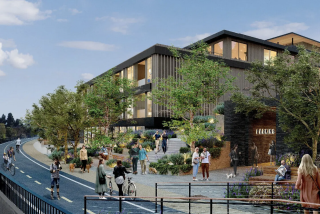In Defense of La Pensione Hotel
Dirk Sutro is in disagreement with the group of distinguished architects who recently gave La Pensione Hotel at India and Date streets an award for design excellence (“When Old and New Mix Like Oil and Water,” Oct. 3). I find it encouraging that my work is taken seriously enough to engender such strongly felt opinions.
Issues of taste and preference aside, however, I think Mr. Sutro has done his public, and the Harborview community in particular, a serious and perhaps unintended disservice regarding important issues of historical preservation. I fear his words will be used by developers everywhere to justify scraping their site clean of our cherished but often imperfect past.
Mr. Sutro believes that adaptive use of older structures has no place in the vocabulary of the built environment. Either perfectly preserve (embalm) it, he says, or rip it down. This simplistic, black-or-white, love-it-or-leave-it attitude is fueling the wholesale destruction of our neighborhoods. Mr. Sutro’s words are another log on this fire.
Given this either-or choice, we know what the results will be: save the few authentic architectural gems and scrape the rest.
Unlike some cities, San Diego does not have a plentiful heritage of architectural masterpieces. Few buildings here can legitimately be designated historical, and fewer still survive the political process such a designation requires.
What San Diego does have is a rich heritage of charming but not remarkable working-class buildings. In the downtown area, and in Harborview especially, these structures take the form of simple one-story warehouses and small retail structures. The qualities usually associated with architecture worth saving are absent here--no inspiring interior spaces, no rich detailing, no exceptional craft. In fact, these structures have only their much-altered facades or a quirky detail or two to lend to the street.
Does this mean, as Mr. Sutro suggests, that they should all be scraped clean? I think not. Taken together, these unremarkable buildings serve as a memory of a more human, pedestrian-oriented past. Without the continuity to the past they provide, our neighborhoods are uprooted. They lose both dignity and identity. Saving even facades or remnants provides for a richness in the fabric of the neighborhood as the new is layered over the old. It is this concept of layering that is missing from past and current redevelopment attitudes.
In the downtown Marina redevelopment area, for instance, the most successful blocks have newly built structures “working around” historic buildings or fragments of old structures. The least successful blocks were scraped clean to accommodate new structures in a “pure” and more “efficient” architectural composition.
Harborview is designated to be over six times more dense than it now is and stands to be the next focus of high-density construction. The Harborview community, working with a creative Historical Sites Board, recently devised an innovative program to save its cherished but imperfect past without discouraging high-density revitalization of the neighborhood.
The Harborview program does not encourage Disneyland-like mimicking of historical styles, as Mr. Sutro implies. It seeks to save the remnant as it is found, adapt it honestly to modern use and carefully integrate it into the larger composition of a contemporary urban building. The result will be a messy, unpredictable and somewhat spontaneous collage of old and new. In short, a neighborhood.
La Pensione may or may not be an artistic success. At issue is whether or not it points to a more meaningful way to redevelop our most colorful and densely urban neighborhoods. If it doesn’t, I fear it’s back to black and white.
ROB WELLINGTON QUIGLEY
San Diego
More to Read
The biggest entertainment stories
Get our big stories about Hollywood, film, television, music, arts, culture and more right in your inbox as soon as they publish.
You may occasionally receive promotional content from the Los Angeles Times.










